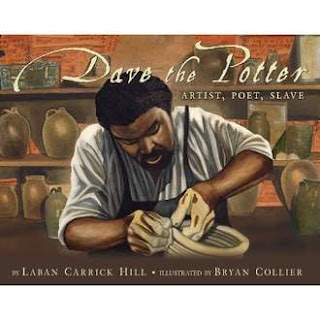Monday Morning Book Review: Dave the Potter
Dave the Potter: Artist, Poet, Slave
by Laban Carrick Hill, Illustrated by Bryan Collier
I found this gem in the bookstore at the National Council of Social Studies meeting last week and hoped it would be a "must have," and it is. What a beautiful book--the illustrations, the poetry--and remarkable true story behind a nineteenth-potter.
Inspired during a conference on the Middle Passage, Laban Carrick Hill began to research one of the potters brought to light by presenter Dr. Lisa Gail Collins. Dave's pottery stood out. For one, the size of the pots were remarkable. Dave threw behemoth pots, we're talking LARGE. Over 60 pounds of raw clay per pot thrown on a wheel with extra thick coils added for the finish. That's as much as my daughter weighs! Dave was one of only two potters who could produce pots this large and he produced an astounding 40,000 pots over his 70 year career.
What grips the reader is the not size of his pots or the dearth of his work, however, but once in a while Dave incised his own poetry into the body of the pots. One inscription dated August 16, 1857 reads, "I wonder where is all my relation/friendship to all--and, every nation." Or another dated July 12, 1834 the says, "put every bit all between/surely this Jar will hold 14." Several more are included throughout and at the end of the book.
From an archaeological perspective the book is a ready-made visual aid to describing the manufacture of nineteenth-century earthenware. The author and illustrator show Dave sourcing clay, forming the vessel using two techniques, making and applying glaze, and finally incising the pots with his own words. What a gift to public archaeologists! You may be surprised by this fact, but few classes can identify the material that makes up a ceramic. If you show them a pottery sherd, they'll tell you its made of glass or stone. It is difficult to rewire their brains to think of ceramics as made from clay.
 The illustrations that accompany the poem are just stunning. In the end notes you learn the artist took a pilgrimage to the land where Dave was known to work and gained a better understanding of his environment and context. The fabric of rural South Carolina is woven into the pigments. On a more literal level, familiar objects to Dave and enslaved people of that time are also incorporated in the backgrounds and can promote further discussion with students.
The illustrations that accompany the poem are just stunning. In the end notes you learn the artist took a pilgrimage to the land where Dave was known to work and gained a better understanding of his environment and context. The fabric of rural South Carolina is woven into the pigments. On a more literal level, familiar objects to Dave and enslaved people of that time are also incorporated in the backgrounds and can promote further discussion with students.Borrowing heavily from the interpreters tool kit, a ready made activity to accompany this book at a library program would be to pass around a broken piece of earthenware before and after the reading of this book. Students could describe on the first pass what the sherd looks like: sharp, brown, shiny, chalky. After reading the book I would imagine students could not help but move from tangible to intangible descriptors for the artifact: pride, art, poetry, history.
 |
| (this illustration is my favorite, note the faces in the tree limbs behind Dave) |
For more information purchase your own copy today for your library. Also, the author generously included a bibliography and website to find out more:
An educator's guide to Dave
Biography of Dave
Dave Biographer Leonard Todd's website

